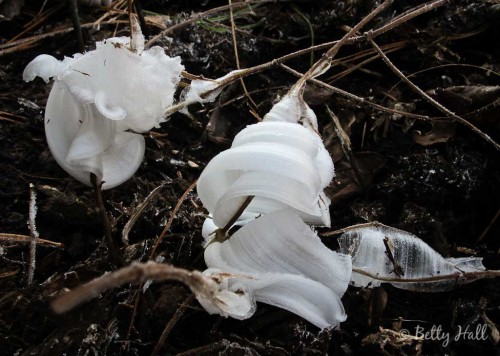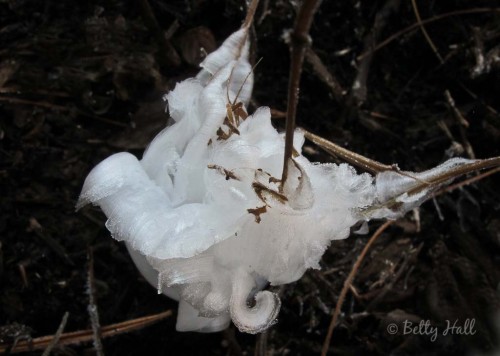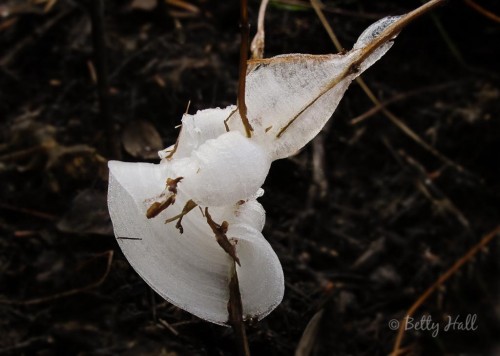I’ve been fascinated by frost flowers since I was a kid and have seen them in the wild in Missouri and Kentucky. On a couple of recent frosty mornings I was thrilled to find them in our backyard.test
Frost “flowers” are really ice crystals which occur only on certain plants and under special conditions when the air temperature is below freezing and the ground is not frozen.
Cold temperatures cause moisture in the plants’ thick roots to expand and push up through the stem. As the water reaches the cold air, it freezes into fantastic, beautiful, fragile shapes. Read more on Wikipedia.
Frost flowers occur on very specific plants, including White Crownbeard (Verbesina virginica) also called Frostweed, Wingstem (Verbesina alternifolia) and Yellow Ironweed (Actinomeris alternifolia). These are weedy plants that often grow in open fields and can grow 8-10 ft. tall, and are not what I want in our backyard.
Frost flowers also occur on Dittany (Cunila origanoides). This is a delicate-looking plant, 12-16″ tall, with small lavender flowers in September or October. It prefers sun or medium shade and dry-to-average soil. According to the plant label, it does not spread and is long-lived, and it works well in a garden.
One must get out early to see these exquisite ice crystals. Even in the shade they usually disappear by 9 or 10 a.m. Our daughter calls them fairies’ ice sculptures. I see them as one more example of nature’s mysterious and beautiful works of art.
If you want to know more, Kentuckian Chris Korrow has created an informative and artful frost flower DVD that has been shown on Kentucky Education Television and is available on his website.
The frost flowers in these photographs were on two Dittany plants in our backyard. I planted them in hopes of having frost flowers close at hand and am glad I did. I’ll be watching them closely on frosty mornings, and I’ll be planting more Dittany in the backyard next spring.
I’ve read that only one person in a thousand has ever seen frost flowers or even knows they exist. I think they are amazing and wish more folks knew about them. Please share this post with anyone you think might be interested. Note the new links at the top of each post to share on Facebook, Twitter, etc.
Have you seen frost flowers? If so, where and when?





Betty, wonderful, I knew it was time for them, and have seen them on a backroad close to here, but was a fence between me and the flowers..
Just wonderful…thank you for sharing..
Beautiful! I am one of the many that’s never seen these before! Thanks for this post!
Kathy, knowing they exist is a first step and I do hope you get to see them.
These are beautiful!! I had not heard of Frost Flowers in the context of real frost, only as a lace knitting pattern (one of the first lace knitting patterns I knit). Now I know what inspired the knitting pattern. I found Dittany listed in a local herb catalogue, and as a magical plant on a Harry Potter site for healing wounds. Apparently it is both beautiful and useful! Thanks Betty for letting us all know about another wonder in the backyard.
Marsha, a knitting pattern, in a herb catalog, and a magical plant on a Harry Potter site for healing wounds? That’s news to me and interesting. Thanks for sharing.
WOW!! This new for me. Thank you for sharing…..amazing……
Christine, yes, they are amazing. I’m hoping other folks will plant a Dittany plant or two to see if they get similar results.
Betty, I am not one of the thousand! I have seen frosted plants, but do not remember any like these designs.
David, glad you’ve seen them. I think there is a wide variety of shapes and the larger plants often have larger “flowers”.
Such magic! I had not heard of them before but am thankful I have now. They are
the ephemeral fodder that naturally finds itself becoming the telling title of a short story or novel Thank You!
Beth, they do seem magical. I like your phrase of “ephemeral fodder” and look forward to the short story or novel.
Cool! I’ll be looking for them on my frosty hikes from now on.
Keli, it would be great to know if you can find them in Utah. I’ve read of them being in Texas. Hope you see some.
Dittany, another ‘must have’ plant!
Yes, Linda, I agree.
I’ve never ever seen frost flowers in my life! They are AWESOME!!!!!. We never have seen frost flowers in our backyard, though I wish we had some.
Parker, thanks for your comment. I’m glad you like the frost flowers. Your grandpa likes them too. If you tell him that you want to plant some dittany plants so you can have frost flowers I bet he might help you out.
We first found these on White Crownbeard plants at the edge of a field along a creek bank on our farm about 5 years ago. Of course they had been there for decades or longer, but – as you note – you have to be out early and on some very cold days to see them. I have since been obsessed with photographing them and have had some extraordinary experiences while doing so (including photographing an ice CRYSTAL that had formed on top of a layer of frost – like a huge hoar frost last year). I’ve posted my pictures at this link: http://gallery.dragonzlair.homeip.net:81/main.php?g2_view=core:ShowItem&g2_itemId=50449
Mary Ann, sorry for the delay. I was delighted to hear from you. You are indeed a frost flower enthusiast and I thoroughly enjoyed the slide show of your photos. You’ve obviously endured cold temperatures to capture so much beauty. Thanks, too, for the video link. Glad to know others also appreciate this winter happening, have captured it, and shared it. I’m envious that you live on a farm where the crown beard grows wild. We have one white crown beard plant and two small dittany plants that I will be watching closely these next few weeks. Thanks for being in touch.